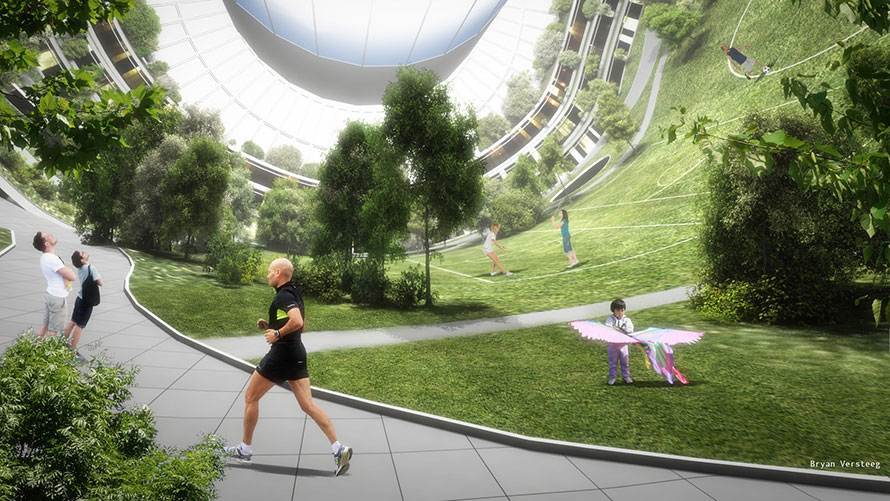By Al Globus
NSS Board of Directors
Here’s an intriguing approach to an early free-space settlement. These settlements rotate to produce artificial gravity so the kids will grow up with strong bones and muscles. Launch cost is the most vexing problem for building such settlements. Maybe not for long though.
In May of 2020 Wccftech.com published “SpaceX Could Bring Starship Launch Costs Down To $10/kg Believes Musk” by Ramish Zafar based on speculation by Elon Musk and others. While this seems extreme, SpaceX is certainly one of the premier rocket companies of our time, so perhaps we should at least listen respectfully and think of what this might imply.
In 2017 a group of us published a technical paper called “Space Settlement: An Easier Way.” This shows how careful placement of rotating space settlements in Equatorial Low Earth Orbit (ELEO, from 500 to 700 km up) would require only a launcher for transportation. More important, these settlements would require little or no radiation shielding as ELEO has low radiation levels by space standards (according to calculations done with Oltaris, which is NASA’s web front end to sophisticated radiation codes). Not needing much shielding radically reduces system mass. Mass and system size can be further reduced, compared to common settlement designs, by rotating fast, up to four rpm. People typically adapt to this rotation rate in a few hours or days–a bit of a problem for tourists, but not a major issue for residents.
According to the paper, a small settlement of 500 settlers would require roughly 17 tons/person for materials. Using optimistic estimates of precursors of the SpaceX StarShip, transportation cost would be about $70/kg for materials and $100,000 per settler. This implies that the cost to transport one settler and their share of materials would be about $1.3 million. A lot but not out of the question. Now plug in $10/kg. You get $270,000 per settler. Now we’re talking!
However, this is just transportation cost. Assuming materials and construction are roughly the same as transportation (a big if), then the cost to move into your space condo is about $540,000 per settler, well within the range where a lot of people could seriously consider living in space. Maybe even you.
Save your pennies.




















6 thoughts on “Space Settlement on the Fast Track”
In the 1980s Marshall Savage came out with the idea (in the book “Millennial Project”) of generating electricity at sea from the considerable temperature differentials between surface and not very deep layers of water in tropical latitudes; then some of this electricity could be used for tightly focused lasers aimed at receivers on ships being launched; the ships would contain only water, which would be vaporized by the lasers, the steam providing the propellent to bring the ship to LEO. Nearly all the habitat construction materials would come from Luna, using photovoltaic energy and electromagnetic launch systems from the Lunar surface. Savage didn’t offer numbers, but if feasible, this sounds far cheaper than rocket propellants. Savage and his organization sorta vaporized, and I stopped hearing about this. Do Savage’s ideas have merit now, at least for giving it another look? Can anyone offer concrete prices per kg launched compared to the Space-X estimates?
$10/kg is far lower than any other near term (next decade or so) launcher of any kind. Actually, so is $70/kg.
Would these space stations in Equatorial Low Earth Orbit be safe from the Electromagnetic Pulse generated by nuclear weapons if there was a full-scale nuclear war between the United States and Russia?
Savage’s book is great and it really swings hard. What I’m trying to do is much different: find the settlement that is easiest to build. SpaceX is already building the rocket and testing it. It’s placed in LEO because it’s easy to get to (relatively) and if you stay close to the equator radiation is pretty low enormously reducing the mass that must be taken up. Spinning fast makes the system small and relatively easy to build. I’m pretty sure this proposal is the easiest settlement (as opposed to a space station) that can be created that I might want to live in it. Check out http://space.alglobus.net/papers/RadicallyEasier.pdf for an accessible version.
A typical estimate for minimum launch costs is $50/lb for cargo and $20,000 per passenger. Add on 10% for profit on cargo and 25% for passenger making it $25,000 per ticket. The origin for these numbers are based on a single stage to orbit vehicle where it requires 90 pounds of propellant to place one pound of cargo into orbit. The cost of 90 lbs of propellant being $20. In the airline industry there is a 60:40 split between personnel and hardware costs to fuel costs. So this leaves $30 split between hardware and personnel. Doubling these numbers for passengers assumes that a 200 lb passenger requires 200 lbs in support equipment (life support, acceleration couch, etc). A rocket working with a Sky Hook could drop these numbers by a factor of eight. A ticket price of $3,000
Being in LEO won’t protect from EMP much if at all. ELEO settlements are unlikely to survive a large Earth based nuclear war. The only real solution to nuclear war is to not have one.